2. China MCC17 Group Co., Ltd., Ma'anshan 243000, Anhui, China
With the acceleration of urbanization and the rapid development of urban transformation and construction industry, concrete has become one of the most extensively used structural materials in the world. Being the main building material, concrete consumes approximately ten billion tons of natural aggregate every year. The exploitation of natural aggregates causes severe damage to the natural environment and a substantial waste of natural resources. Therefore, there are urgent needs for the solutions of saving natural aggregate, investigations of natural aggregate substitutes of concrete, and the application to the engineering field.
Steel slag, which is the industrial waste during steel-making, accounts for 15%-20% of all steel productions[1-2]. Currently, the main utilizations of steel slag are as raw materials for steel-making and iron-making, back-filling materials for road construction, and raw materials for producing cement or concrete admixtures[3-8].
In recent years, the fundamental performances of Steel Slag Concrete (SSC), where steel slag rather than cement or concrete aggregate is used, have been investigated. Results demonstrated that concrete mixed with steel slag exhibits the characteristics of low hydration heat, high compressive strength, and reasonable durability[9-13]. However, the volume instability of steel slags during hydration reaction limits their applications. Therefore, several scholars put forward certain measures to inhibit the expansion of steel slag, such as carbonizing or aging the steel slag, adding fly ash or siliceous materials, and decreasing the content of free CaO and MgO[14-19].
Concrete Filled Steel Tubes (CFSTs) have been extensively applied in bridge piers, pile foundations, and high-rise buildings owing to their extraordinary load capacity and excellent ductility[20-24]. However, the shrinking of ordinary concrete in CFSTs is obvious, which is likely to decrease the bond performance between steel tube and concrete, as well as deteriorate the mechanical properties of CFSTs. The expansion behavior of SSC was employed to remedy the defects of ordinary CFST in this study. SSC with controllable expansion rate was proposed by designing the mix proportion ratio. The application of the reasonable expansion SSC as an infill can effectively decrease the shrinking cracks in concrete as well as enhance the bond performances and mechanical behaviors of the CFSTs. Compared with ordinary concrete, the core SSC entered three-axial compression stress in advance. Filling this self-stressing SSC in tubes can hinder the premature development of micro-cracks and improve the operating performance. Ferhoune et al.[25-26] performed abundant experimental studies to investigate the axial compression and eccentric compression behaviors of welded steel tube filled with slag concrete, aiming at proving that slag can be integrated in the manufacturing of nontraditional concrete. Zeghiche[27] conducted a total of 26 thin cold fabricated SSC stubs and examined the influences of height, section shape, welding fillet nature, and concrete age on load carrying capacity. Test results demonstrated the outward local buckling dominated failure of all stubs, and the length exerts a drastically effect on the load carrying capacity. Beggasa and Zeghiche[28] carried out an experiment to investigate the thermal conductivity of SSC filled steel tube for light steel buildings. Results showed that the composite column is not only beneficial to the sustainable development of recyclable materials, but also helpful to reduce heat loss. Currently, scholars have attempted to apply SSC to CFST, while the expansion behavior of SSC was not considered in these studies. No evidence is attainable in literature to ascertain the effect of the expansion behavior of SSC on the mechanical behavior of this composite column.
In this paper, the expansion behavior of Full Aggregate Steel Slag Concrete (FASSC) is investigated through orthogonal experiment, in which fine aggregate and coarse aggregate in concrete were replaced by fine steel slag sand and coarse steel slag. Parameters such as sand ratio, water-cement ratio, steel slag sand content, replacement particle size of steel slag sand, coarse steel slag content, and replacement particle size of coarse steel slag were considered. An analytical approach for approximately predicting the expansion rate of FASSC was proposed and the mix proportions of SSC for self-stressing CFST and shrinkage compensating SSC were suggested.
2 Experimental Program 2.1 Raw Materials[29-30] 2.1.1 CementIn this experiment, Portland cement of strength grade 42.5 MPa was employed as the generator of steel slag activity, whose main chemical composition and physical properties are presented in Tables 1-2.
| Table 1 Chemical composition of cement (%) |
| Table 2 Physical properties of cement |
2.1.2 Sand and stone
Sizes of steel slag sand and common sand were measured by an electric vibrating screen machine, and the classification index was determined. Results demonstrated that the fineness moduli of the steel slag sand and the common sand were 2.58 and 2.77. Steel slag sand and common sand both belonged to the zone II of medium sand. The stones were graded continuously and the particle size of the stone was 5 mm-31.5 mm.
2.1.3 Chemical composition of steel slagThe main chemical compositions of the steel slag obtained from Ma'anshan Iron and Steel Co. were determined by X-ray fluorescence spectrometry (XRF), as presented in Table 3. The main mineral phases are C3S, C2S, RO, and C2F.
| Table 3 Chemical composition of steel slag (%) |
2.1.4 Water content of concrete aggregate
An oven was employed in the test, and the water content of the concrete aggregate was determined, as presented in Table 4. It can be observed that the water content of the concrete aggregate decreased with the increase of the particle size of steel slag sand. Moreover, water content of steel slag sand with full particle size was fundamentally identical to that of ordinary sand.
| Table 4 Concrete aggregate (%) |
2.2 Test Design
Effects of sand ratio, water-cement ratio, steel slag sand content, replacement particle size of steel slag sand, coarse steel slag content, and replacement particle size of coarse steel slag on the expansion behavior of FASSC were investigated by means of orthogonal experimental study. The test was conducted in accordance with the Chinese code GB/T50080-2016[31]. The quantitative levels of each factor are listed in Table 5. Table 6 presents the orthogonal test design of FASSC, and the amount of various materials of SSC is shown in Table 7.
| Table 5 Quantitative levels of each factor[32] |
| Table 6 Orthogonal test design of FASSC |
| Table 7 The amount of various materials required for different SSC per cubic meter |
2.3 Testing Method of Expansion Rate
The current code does not specify the test method of expansive concrete and cannot provide calculation formula of expansion rate. Besides, expansion can be regarded as negative shrinkage. Thus, the expansion rate of SSC was determined according to the Chinese code GB/T50082-2009[33] in this study. The dimension of the tested block is 100 mm × 100 mm × 300 mm, whose effective length is the distance between two copper heads, as shown in Fig. 1.
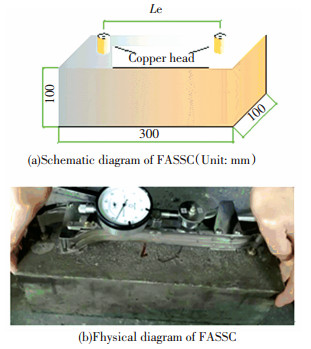
|
Fig.1 Device for measuring the expansion rate of SSC |
The FASSC test blocks were demolished 24 h after the completion of production and maintained in a standard maintenance box. The first length measured with a hand-held strain gauge after three days of maintenance was designated as the reference length L0. Subsequently, the test blocks were taken out each day to measure their length Lt. The formula for calculating the expansion rate of FASSC Pt is as follows:
| $ {P_t} = \frac{{{L_t} - {L_0}}}{L} $ | (1) |
where Pt is the expansion rate of FASSC on the tth day, L is the effective length, L0 is the initial reference length on the three days, and Lt is the length on the tth day.
3 Results and Discussion 3.1 Intuitive AnalysisResults of the 30-day expansion test on SSC are presented in Table 8. In order to study the influence of various factors on the expansion rate of FASSC, the test results of the expansion rate of FASSC were analyzed intuitively in this study, as illustrated in Table 9. According to the extreme difference D in the table, D3>D4>D2>D1>D5>D6. The results demonstrated that steel slag sand content exerted the most significant effect on the expansion rate of FASSC, followed by the replacement particle size of steel slag sand, water-cement ratio, sand ratio, and coarse steel slag content. Replacement particle size of coarse steel slag exerted the least influence on the expansion rate of FASSC.
| Table 8 Test results of expansion rate of FASSC |
| Table 9 Intuitive analysis of expansion rate of FASSC |
3.2 Index-Factor Relationship
In order to intuitively compare and analyze the relation between expansion rate and various factors of FASSC, index-factor analysis on the expansion rate of FASSC was conducted. Fig. 2 reveals the influence of sand ratio A on the expansion rate of FASSC.

|
Fig.2 Effect of sand ratio |
The graph revealed that the influence range of sand ratio A on the expansion rate of FASSC was marginal. With an increase in the sand ratio, the expansion rate of FASSC first decreased and then increased. It is mainly because with an increase in sand ratio, the amount of steel slag sand increased and the expansion rate of FASSC increased gradually. Fig. 3 depicts the influence of water-cement ratio B on the expansion rate of FASSC, which showed that as water-cement ratio increased, the expansion rate of FASSC first increased and then decreased. The reason is that when the water-cement ratio was large, the expansion stress produced by steel slag was larger than the shrinkage force of the concrete, and FASSC was in the expansion state. When the water-cement ratio was marginal, the expansion caused by steel slag was not adequate to compensate for the shrinkage of concrete, and FASSC was in shrinkage state.
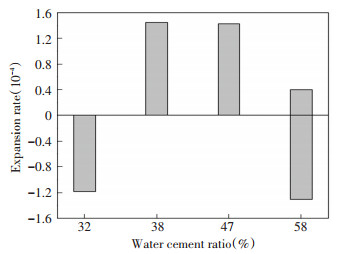
|
Fig.3 Effect of water-cement ratio |
Fig. 4 shows the influence of steel slag sand content on the expansion rate of FASSC. It revealed that the effect of steel slag sand content on the expansion rate of FASSC was significant, and with an increase in steel slag sand content, the expansion rate of FASSC first increased and then decreased. This is mainly because when the steel slag sand content was marginal, the steel slag could fully participate in the alkali aggregate reaction in concrete. With a gradual increase in steel slag sand content, the redundant steel slag sand resulted in the shrinkage of SSC.

|
Fig.4 Effect of steel slag sand content |
Fig. 5 shows the influence of replacement particle size of steel slag sand on the expansion rate of FASSC. It can be found that with an increase in the replacement particle size of steel slag sand, the expansion rate of FASSC decreased gradually. The reason might be that the specific surface area of fine particle size steel slag was large, the lattice was prone to recrystallization, and water molecules were easy to come into the steel slag. In addition, f-CaO was divided into single phase and solid solution phase. The single phase CaO could be completely hydrated to Ca(OH)2 at room temperature, while the solid solution phase CaO could be only partially hydrated to Ca(OH)2 at a high temperature. The content of the single phase CaO in fine particle size steel slag was high, whereas that of the solid solution phase was low. The molar volume of Ca(OH)2 and Mg(OH)2 was greater than that of water loss during hydration process of steel slag[34-35].
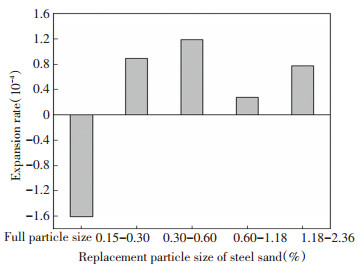
|
Fig.5 Effect of replacement particle size of steel slag sand |
Fig. 6 shows the influence of coarse steel slag content on the expansion rate of FASSC, in which the expansion rate of FASSC decreased with an increase in the coarse steel slag content. This may come from that the porosity of steel slag was relatively large, and the crushing value of steel slag was lower than that of common stone. Fig. 7 depicts the effect of the replacement particle size of coarse steel slag on the expansion rate of FASSC. It showed that with the increase of the replacement particle size of coarse steel slag, the expansion rate of FASSC decreased gradually. It might be because that specific surface area of steel slag decreased as the replacement particle size of coarse steel slag increased.
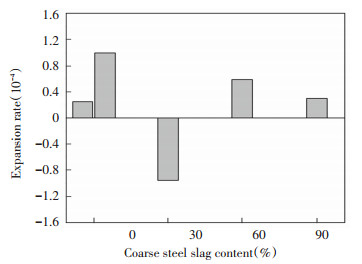
|
Fig.6 Effect of coarse steel slag content |

|
Fig.7 Effect of replacement particle size of coarse steel slag |
Figs. 2-7 show that the volume expansion rate of FASSC designed by A1B3C3D3E2F2 factor combination was the largest. In contrast, among these factors, the steel slag sand content and the replacement particle size of steel slag sand significantly affected the expansion rate of FASSC. With the increase of steel slag sand content or replacement particle size of steel slag sand, the expansion rate of FASSC increased gradually.
3.3 Interaction EffectTo investigate the influences of sand ratio A and water-cement ratio B, as well as sand ratio A and steel slag sand content C on the expansion rate of FASSC, the corresponding interactions were analyzed. Table 10 illustrates that when sand ratio A was constant, the expansion rate of FASSC decreased with an increase in water-cement ratio B. When water-cement ratio B was constant, the expansion rate of FASSC increased marginally with the increase of sand ratio A. When sand ratio A was constant, the expansion rate of FASSC increased with the increase of steel slag sand content C. When steel slag sand content C was constant, the expansion rate of FASSC decreased marginally with an increase in sand ratio A.
| Table 10 Interaction between sand ratio A and water-cement ratio B (steel slag sand content C) |
The interactions between sand ratio A and the replacement particle size of steel slag sand D, as well as sand ratio A and coarse steel slag content E are shown in Table 11, in which when sand ratio A was constant, the expansion rate of FASSC decreased gradually with an increase in the replacement particle size of steel slag sand D. When the replacement particle size of steel slag sand D was constant, the expansion rate of FASSC decreased gradually with an increase in sand ratio A. It is obvious that when sand ratio A was constant, the expansion rate of FASSC accompanying an increase in coarse steel slag content E was not apparent. When coarse steel slag content E was constant, the expansion rate of FASSC increased gradually with an increase in sand ratio A. To understand the influences of water-cement ratio B and steel slag sand content C, as well as water-cement ratio B and the replacement particle size of steel slag sand D on the expansion rate of FASSC, the interactions were analyzed, as presented in Table 12. The table illustrates that when water-cement ratio B was constant, the expansion rate of FASSC increased gradually with an increase in the steel slag sand content C. When steel slag sand content C was constant, the expansion rate of FASSC decreased gradually with the increase of water-cement ratio B. When water-cement ratio B was constant, the expansion rate of FASSC decreased gradually with the increase of replacement particle size of steel slag sand D. When the replacement particle size of steel slag sand D was constant, the expansion rate of FASSC decreased gradually with the increase of water-cement ratio B.
| Table 11 Interaction between sand ratio A and replacement particle size of steel slag sand D(coarse steel slag content E) |
| Table 12 Interaction between water-cement ratio B and steel slag sand content C (replacement particle size of steel slag sand D) |
To analyze the influence of water-cement ratio B and coarse steel slag content E on the expansion rate of FASSC, the interaction between water-cement ratio B and coarse steel slag content E was studied, as presented in Table 13. It showed that the expansion rate of FASSC decreased with the increase of coarse steel slag content E when the water-cement ratio B was constant.
| Table 13 Interaction between water-cement ratio B and coarse steel slag content E |
Meanwhile, the expansion rate of FASSC decreased with an increase in water-cement ratio B when the coarse steel slag content E was constant.
The interactions between steel slag sand content C and the replacement particle size of steel slag sand D, as well as between steel slag sand content C and coarse steel slag content E are shown in Table 14. The table illustrates that when steel slag sand content C was constant, the expansion rate of FASSC gradually decreased with the increase of the replacement particle size of steel slag sand D. When the replacement particle size of steel slag sand D was constant, the expansion rate of FASSC increased gradually with the increase of steel slag sand content C. When steel slag sand content C was constant, the expansion rate of FASSC first increased and then decreased. When coarse steel slag content E was constant, the larger the replacement particle size of steel slag sand was, the larger the expansion rate of FASSC became.
| Table 14 Interaction between steel slag sand content C and replacement particle size of steel slag sand D(coarse steel slag content E) |
To analyze the influence of replacement particle size of steel slag sand D and coarse steel slag content E on the expansion rate of FASSC, the interaction between replacement particle size of steel slag sand D and coarse steel slag content E was investigated, as presented in Table 15. It revealed that the expansion rate of FASSC decreased with the increase of coarse steel slag content E when the replacement particle size of steel slag sand D was constant. Meanwhile, the expansion rate of FASSC first increased and then decreased with the increase of the replacement particle size of steel slag sand D when the coarse steel slag content E was constant.
| Table 15 Interaction between replacement particle size of steel slag sand D and coarse steel slag content E |
3.4 Variance Analysis
To analyze the significance of the expansion rate of FASSC, a variance analysis of the expansion rate of FASSC was carried out in this study, as presented in Table 16. When the confidence interval was 0.05, there was no significant factor affecting the expansion rate of FASSC. A comparison of the F value of each factor revealed that F value of steel slag sand content was the largest, and it exerted a significant influence on the expansion rate of FASSC.
| Table 16 Variance analysis |
3.5 Expansion-Time Analysis
To analyze the change rule of the expansion rate of FASSC with time, the expansion-time curves of FASSC are plotted in Fig. 8. Obviously, the expansion rate of FASSC at the early stage did not change significantly with time. This may come from that different from the expansive concrete with expansive agent or expansive cement, the early expansion behavior of SSC was weak. The early expansion behavior of expansion agent or expansion cement was significant while the expansion behavior of SSC was produced by the volcanic ash activity of steel slag. The hydration reaction of steel slag was a slow process. At the initial stage, the hydration reaction of steel slag was not enough and the expansion was relatively weak. The figure also demonstrated that the expansion rate of FASSC first increased and then decreased with time. However, the shrinkage trend of certain FASSC was not obvious, which was mainly because the amount of steel slag was less under this mix ratio.
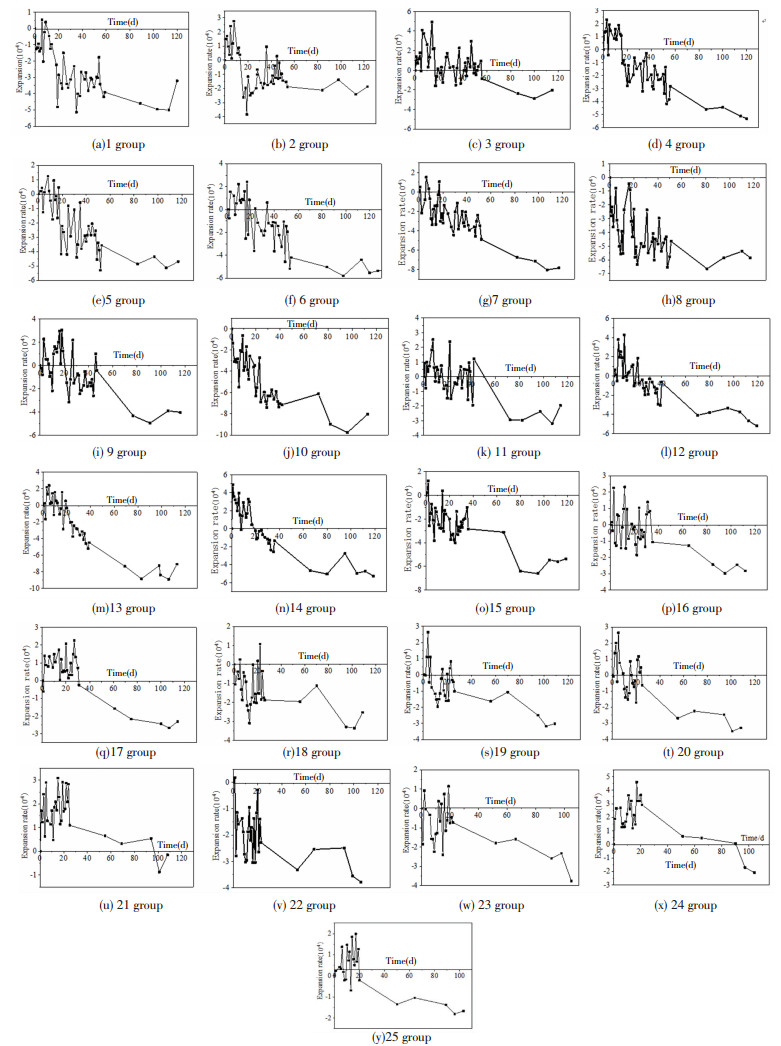
|
Fig.8 Expansion rate of SSC |
From Fig. 8 (c), (f), (i), (k), (p), (u), and (x), it can be found that FASSC was in a state of expansion after 30 days, whose expansion rate was 1×10-4 - 3×10-4, which satisfied the design requirements of expansive CFST. The expansion rate in Fig. 8 (u) and (x) satisfied the requirements of the optimal expansion rate of CFST proposed in Ref. [21].
According to Fig. 8 (d), (g), (l), (m), (s), (t), (w), and (y), the expansion rate of FASSC was within the range of (-1×10-4, 1×10-4) and could be used to prepare shrinkage compensating SSC. In Fig. 8 (a), (b), (e), (f), (h), (j), (n), (o), (q), (r), and (v), it is obvious that FASSC was in a shrinkage state. Moreover, the expansion caused by steel slag was inadequate to compensate for the shrinkage of concrete, resulting in a certain shrinkage of FASSC. Unlike the reference concrete, the expansion of FASSC exhibited a certain convergence trend. The convergence trend became more gradual with the increase of steel slag content and replacement particle size.
According to the test results, the relation between the expansion rate of FASSC and three most important factors could be obtained by single factor weighted fitting analysis of experimental data.
| $ \begin{array}{*{20}{l}} {P = \frac{4}{{21}}\left( {2063 \cdot {W^3} - 2829 \cdot {W^2} + 1261 \cdot W - } \right.}\\ {\;\;\;\;\;183.1) + \frac{6}{{21}}\left( {16.22 \cdot {E^3} - 29.17 \cdot {E^2} + } \right.}\\ {\;\;\;\;\;15.54 \cdot E - 1.817) + \frac{5}{{21}}\left( {10.66 \cdot D_{\rm{m}}^3 - } \right.}\\ {\left. {\;\;\;\;\;30.15 \cdot D_{\rm{m}}^2 + 20.98 \cdot {D_{\rm{m}}} - 2.922} \right)} \end{array} $ | (2) |
where P is the expansion rate of FASSC, W is the water-cement ratio, E denotes the steel slag sand content, and Dm is the average replacement particle size of steel slag sand.
While preparing SSC with steel slag, Eq. (2) can be used to approximately determine whether the SSC with this mixture ratio can be prepared with shrinkage-compensating SSC and expansive SSC.
Based on the experimental data of FASSC, the mix design of six groups of expansive SSC was extracted in this study, as presented in Table 17. These mix ratios satisfied the design requirements of concrete expansion rate in self-stressing CFST and could be employed to prepare self-stressing steel slag CFST. The expansion rate curves of each group of SSC for 60 days are shown in Fig. 9.
| Table 17 Mix rate of steel slag expansive concrete |
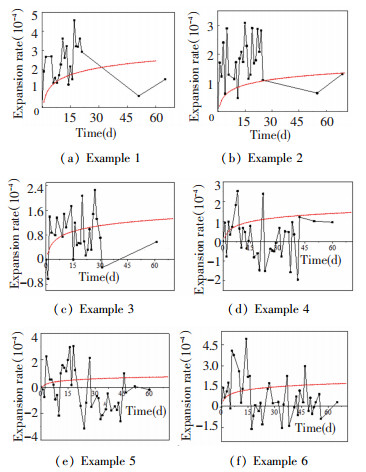
|
Fig.9 Expansion-time curves of expansive SSC |
4 Conclusions
In this study, an orthogonal experimental investigation on the expansion rate of FASSC was carried out. Effects of sand ratio, water-cement ratio, steel slag sand content, replacement particle size of steel slag sand, coarse steel slag content, and replacement particle size of coarse steel slag on the expansion rate of FASSC were analyzed.
1) The orthogonal test analysis of the expansion rate of FASSC illustrated that the steel slag sand content and the replacement particle sizes of steel slag sand exerted significant influence on the expansion rate of FASSC. While the replacement particle size of coarse steel slag showed the least influence on the expansion rate of FASSC. The combination design of A1B3C3D3E2F2 exhibited the largest expansion rate of FASSC.
2) With a gradual increase in the replacement particle size of steel slag sand or the coarse steel slag content, the expansion rate of FASSC decreased gradually. With a gradual increase in the water-cement ratio or steel slag sand content, the expansion rate of FASSC first increased and then decreased. As the sand ratio increased, the expansion rate of FASSC first decreased and then increased.
3) The interaction between any two factors resulted in different influences on the expansion rate of FASSC. The variance analysis revealed that when the confidence interval was 0.05, no factor significantly affected the expansion rate of FASSC.
4) The expansion-time curves of SSC illustrated that the expansion rate increased first and then decreased with the passage of time, which was equivalent to a convergence trend.
5) On the basis of the experimental research, the mix proportions of SSC for self-stressing CFST and shrinkage compensating SSC were suggested. By means of single factor weighted fitting, a formula for approximately predicting the expansion rate of FASSC was proposed.
6) Future research developments will focus on conducting more validations including the validation with data to form the literature, the field validation using different SSC mixtures to be paved under different conditions with different types of curing compound, and the well-known field-validated program considering the uncoupled temperature model and moisture model, as well as investigating the self-stressing steel slag CFST.
| [1] |
Furlani E, Tonello G, Maschio S. Recycling of steel slag and glass cullet from energy saving lamps by fast firing production of ceramics. Waste Management, 2010, 30(8-9): 1714-1719. DOI:10.1016/j.wasman.2010.03.030 (  0) 0) |
| [2] |
Yi H, Xu G P, Cheng H G, et al. An overview of utilization of steel slag. Procedia Environmental Sciences, 2012, 16(4): 791-801. DOI:10.1016/j.proenv.2012.10.108 (  0) 0) |
| [3] |
Jiang Y, Ling T C, Shi C J, et al. Characteristics of steel slags and their use in cement and concrete-A review. Resources, Conservation and Recycling, 2018, 136: 187-197. DOI:10.1016/j.resconrec.2018.04.023 (  0) 0) |
| [4] |
Xue Y J, Wu S P, Hou H B, et al. Experimental investigation of basic oxygen furnace slag used as aggregate in asphalt mixture. Journal of Hazardous Materials, 2006, 138(2): 261-268. DOI:10.1016/j.jhazmat.2006.02.073 (  0) 0) |
| [5] |
Tsakiridis P E, Papadimitriou G D, Tsivilis S, et al. Utilization of steel slag for Portland cement clinker production. Journal of Hazardous Materials, 2008, 152(2): 805-811. DOI:10.1016/j.jhazmat.2007.07.093 (  0) 0) |
| [6] |
Huang Y, Bird R N, Heidrich O. A review of the use of recycled solid waste materials in asphalt pavements. Resources, Conservation and Recycling, 2007, 52(1): 58-73. DOI:10.1016/j.resconrec.2007.02.002 (  0) 0) |
| [7] |
Miraoui M, Zentar R, Abriak N E. Road material basis in dredged sediment and basic oxygen furnace steel slag. Construction and Building Materials, 2012, 30(5): 309-319. DOI:10.1016/j.conbuildmat.2011.11.032 (  0) 0) |
| [8] |
Fuente-Alonso J A, Ortega-López V, Skaf M, et al. Performance of fiber-reinforced EAF slag concrete for use in pavements. Construction and Building Materials, 2017, 149(15): 629-638. DOI:10.1016/j.conbuildmat.2017.05.174 (  0) 0) |
| [9] |
Yu X, Tao Z, Song T Y, et al. Performance of concrete made with steel slag and waste glass. Construction and Building Materials, 2016, 114: 737-746. DOI:10.1016/j.conbuildmat.2016.03.217 (  0) 0) |
| [10] |
Devi V S, Gnanavel B K. Properties of concrete manufactured using steel slag. Procedia Engineering, 2014, 97(2): 95-104. DOI:10.1016/j.proeng.2014.12.229 (  0) 0) |
| [11] |
Khan M S H, Castel A, Akbarnezhad A, et al. Utilization of steel furnace slag coarse aggregate in a low calcium fly ash geopolymer concrete. Cement and Concrete Research, 2016, 89: 220-229. DOI:10.1016/j.cemconres.2016.09.001 (  0) 0) |
| [12] |
Wang Q, Yan P Y, Yang J W, et al. Influence of steel slag on mechanical properties and durability of concrete. Construction and Building Materials, 2013, 47: 1414-1420. DOI:10.1016/j.conbuildmat.2013.06.044 (  0) 0) |
| [13] |
Rondi L, Bregoli G, Sorlini S, et al. Concrete with EAF steel slag as aggregate: A comprehensive technical and environmental characterization. Composites Part B: Engineering, 2016, 90: 195-202. DOI:10.1016/j.compositesb.2015.12.022 (  0) 0) |
| [14] |
Morone M, Costa G, Polettini A, et al. Valorization of steel slag by a combined carbonation and granulation treatment. Minerals Engineering, 2014, 59: 82-90. DOI:10.1016/j.mineng.2013.08.009 (  0) 0) |
| [15] |
Mo L W, Zhang F, Deng M, et al. Accelerated carbonation and performance of concrete made with steel slag as binding materials and aggregates. Cement and Concrete Composites, 2017, 83: 138-145. DOI:10.1016/j.cemconcomp.2017.07.018 (  0) 0) |
| [16] |
Anastasiou E, Filikas K G, Stefanidou M. Utilization of fine recycled aggregates in concrete with fly ash and steel slag. Construction and Building Materials, 2014, 50(50): 154-161. DOI:10.1016/j.conbuildmat.2013.09.037 (  0) 0) |
| [17] |
Wang Q, Wang D Q, Zhuang S Y. The soundness of steel slag with different free CaO and MgO contents. Construction and Building Materials, 2017, 151: 138-146. DOI:10.1016/j.conbuildmat.2017.06.077 (  0) 0) |
| [18] |
Liu J, Wang D M. Influence of steel slag-silica fume composite mineral admixture on the properties of concrete. Powder Technology, 2017, 320: 230-238. DOI:10.1016/j.powtec.2017.07.052 (  0) 0) |
| [19] |
Qasrawi H, Shalabi F, Asi I. Use of low CaO unprocessed steel slag in concrete as fine aggregate. Construction and Building Materials, 2009, 23(2): 1118-1125. DOI:10.1016/j.conbuildmat.2008.06.003 (  0) 0) |
| [20] |
Tomii M, Sakino K. Experimental study of concrete filled steel tubular stub columns under concentric loading. Proceedings of the International Colloquium on Stability of Structures under Static and Dynamic Loads. Washington, D. C.:SSRC/ ASCE, 1977, 718-741. (  0) 0) |
| [21] |
Schneider S P. Axially loaded concrete-filled steel tubes. Journal of Structural Engineering, 1998, 124(10): 1125-1138. DOI:10.1061/(ASCE)0733-9445(1998)124:10(1125) (  0) 0) |
| [22] |
Fujimoto T, Mukai A, Nishiyama I, et al. Behavior of eccentrically loaded concrete-filled steel tubular columns. Journal of Structural Engineering, 2004, 130(2): 203-212. DOI:10.1061/(ASCE)0733-9445(2004)130:2(203) (  0) 0) |
| [23] |
Portolés J M, Romero M L, Filippou F C, et al. Simulation and design recommendations of eccentrically loaded slender concrete-filled tubular columns. Engineering Structures, 2011, 33(5): 1576-1593. DOI:10.1016/j.engstruct.2011.01.028 (  0) 0) |
| [24] |
Han L H, Li W, Bjorhovde R. Developments and advanced applications of concrete-filled steel tubular (CFST) structures: Members. Journal of Constructional Steel Research, 2014, 100(1): 211-228. DOI:10.1016/j.jcsr.2014.04.016 (  0) 0) |
| [25] |
Ferhoune N, Zeghiche J. Experimental behaviour of concrete-filled rectangular thin welded steel stubs (compression load case). Comptes Rendus Mécanique, 2012, 340(3): 156-164. DOI:10.1016/j.crme.2011.11.010 (  0) 0) |
| [26] |
Ferhoune N. Experimental behaviour of cold-formed steel welded tube filled with concrete made of crushed crystallized slag subjected to eccentric load. Thin-Walled Structures, 2014, 80(1): 159-166. DOI:10.1016/j.tws.2014.02.014 (  0) 0) |
| [27] |
Zeghiche J. Further tests on thin steel and composite fabricated stubs. Journal of Constructional Steel Research, 2013, 81(3): 124-137. DOI:10.1016/j.jcsr.2012.11.006 (  0) 0) |
| [28] |
Beggas D, Zeghiche J. The use of slag stone concrete to improve the thermal performance of light steel buildings. Sustainable Cities and Society, 2013, 6(1): 22-26. DOI:10.1016/j.scs.2012.07.004 (  0) 0) |
| [29] |
Yu F, Wang X L, Xu L, et al. Basic performance of the whole steel-slag concrete based on controllable expansion rate. Bulletin of the Chinese Ceramic Society, 2015, 34(6): 1520-1525. (in Chinese) DOI:10.16552/j.cnki.issn1001-1625.2015.06.012 (  0) 0) |
| [30] |
Yu F, Wang X L, Zhang Y, et al. Stress-strain relationship of shrinkage compensating steel-slag concrete. Journal of Building Materials, 2017, 20(4): 527-534. DOI:10.3969/j.issn.1007-9629.2017.04.007 (  0) 0) |
| [31] |
Ministry of Housing and Urban-Rural Development of the People's Republic of China. Standard for Test Method of Performance on Ordinary Fresh Concrete: GB/T50080-2016. Beijing: China Architecture & Building Press, 2016.
(  0) 0) |
| [32] |
Yu F, Zhang Y, Wang X L, et al. Experimental study on compressive strength of full steel slag aggregate concrete. Journal of Basic Science and Engineering, 2018, 26(4): 854-862. (in Chinese) DOI:10.16058/j.issn.1005-0930.2018.04.015 (  0) 0) |
| [33] |
Ministry of Housing and Urban-Rural Development of the People's Republic of China. Standard Test Method for Long-Term and Durability of Ordinary Concrete. GB/T50082-2009. Beijing: China Architecture & Building Press, 2009.
(  0) 0) |
| [34] |
Lyu Y. Study About Expansibility of f-CaO in Steel Slag. Beijing: Beijing University of Chemical Technology, 2017. (in Chinese)
(  0) 0) |
| [35] |
Hou X K, Xu D L, Xue B, et al. Study on volume stability problems of cement caused by steel slag. Journal of Building Materials, 2012, 15(5): 588-595. (in Chinese) DOI:10.3969/j.issn.1007-9629.2012.05.002 (  0) 0) |
 2021, Vol. 28
2021, Vol. 28


